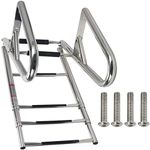Buying Guide for the Best Dock Ladder
Choosing the right dock ladder is important for both safety and convenience when accessing the water from your dock. The best ladder for you will depend on how and where you plan to use it, who will be using it, and the conditions at your dock. By understanding the key features and specifications, you can make a choice that ensures easy access, durability, and comfort for everyone.MaterialThe material of a dock ladder determines its durability, resistance to corrosion, and maintenance needs. Common materials include aluminum, stainless steel, and plastic. Aluminum is lightweight and resists rust, making it a popular choice for freshwater docks. Stainless steel is heavier but offers superior strength and corrosion resistance, especially in saltwater environments. Plastic ladders are lightweight and won’t corrode, but may not be as strong as metal options. Consider the water type (fresh or salt), expected weight load, and how much maintenance you’re willing to do when choosing the material.
Number of StepsThe number of steps on a dock ladder affects how easy it is to get in and out of the water. Ladders typically range from 3 to 7 steps. Fewer steps mean a shorter ladder, which may be fine for shallow water or floating docks, but can make climbing out of deeper water difficult. More steps provide easier access, especially for children or older adults, and are better for docks that sit higher above the water. Think about the height of your dock above the water and who will be using the ladder to decide how many steps you need.
Mounting StyleDock ladders can be fixed, flip-up, or removable. Fixed ladders are permanently attached and always ready to use, but can get in the way or collect debris. Flip-up ladders can be lifted out of the water when not in use, which helps prevent algae buildup and corrosion. Removable ladders can be taken off entirely for storage or winterizing. Consider how often you’ll use the ladder, whether you need to protect it from the elements, and if you want to keep the dock clear when the ladder isn’t needed.
Weight CapacityWeight capacity tells you how much weight the ladder can safely support. Most dock ladders are rated for 250 to 400 pounds. If the ladder will be used by adults, or if people might climb it carrying gear, choose a ladder with a higher weight rating. Always check the manufacturer’s guidelines and consider the heaviest likely user to ensure safety.
Step Width and TreadStep width and tread refer to how wide and deep each step is, and whether the steps have a non-slip surface. Wider, deeper steps are more comfortable and safer, especially for children, older adults, or anyone with mobility issues. Non-slip treads help prevent slipping when the ladder is wet. If comfort and safety are priorities, look for ladders with wide, textured steps.
Angle of the LadderThe angle of the ladder affects how easy it is to climb. Vertical ladders take up less space but can be harder to use, especially for young children or older adults. Angled ladders are easier and more comfortable to climb, but require more dock space. Think about who will be using the ladder and how much room you have on your dock when deciding between a vertical or angled design.




















